Papayas, scientifically known as Carica papaya, belong to the melon family. Originally hailing from South America, Central America, and some parts of North America's southern regions, they are primarily cultivated in tropical areas within the intertropical zone. Papayas are tree fruits—a delightful addition to their vibrant habitat.
The papaya tree has a straight stem reaching up to 10 meters/33 feet tall in its natural state, which is topped with a bunch of large, deeply cut leaves set on long petioles. Papaya flowers possess a funnel-shaped structure, exhibiting a creamy yellow hue. In contrast, papaya fruits showcase an oval or slightly pear-like shape, but they tend to be more sizable.

The color of the papaya can range from vibrant green to a deep orange shade, transforming as it matures. When fully ripened, the papaya exhibits a skin color that predominantly leans toward orange or dark yellow, often accompanied by a subtle green undertone. In contrast, the inside is pink or orange flesh and black, spherical seeds.
Papaya is a delicious fruit with a sweet taste. It contains edible papaya seeds, often avoided due to their bitter flavor. You can enjoy papaya raw, in jams and yogurts, or even candied and canned. It is generally safe for children over one year old to consume papaya, but what about pets? Can papayas be safely consumed by them?
Dogs can enjoy papaya without any negative effects. So, if you want to treat your pets, you can confidently offer them the delicious pulp of this exquisite fruit. Just be sure to remove any peel or seeds. However, it's important to note that not all dogs may have a taste for papaya.

Papaya is a versatile fruit that comes in various colors. As it ripens, the once green flesh transforms into a vibrant shade of orange or dark yellow. The green hue of an unripe papaya signifies its immaturity. Conversely, a ripe papaya boasts a predominantly orange or dark yellow skin, with a subtle hint of green.
When you come across a papaya at the store exhibiting a greenish tint and yellow spots, it indicates its freshness. Harvesters pick the fruit in its green state to ensure optimal quality. Such papayas are best put in a paper bag and stored at room temperature for a few days until they ripen.
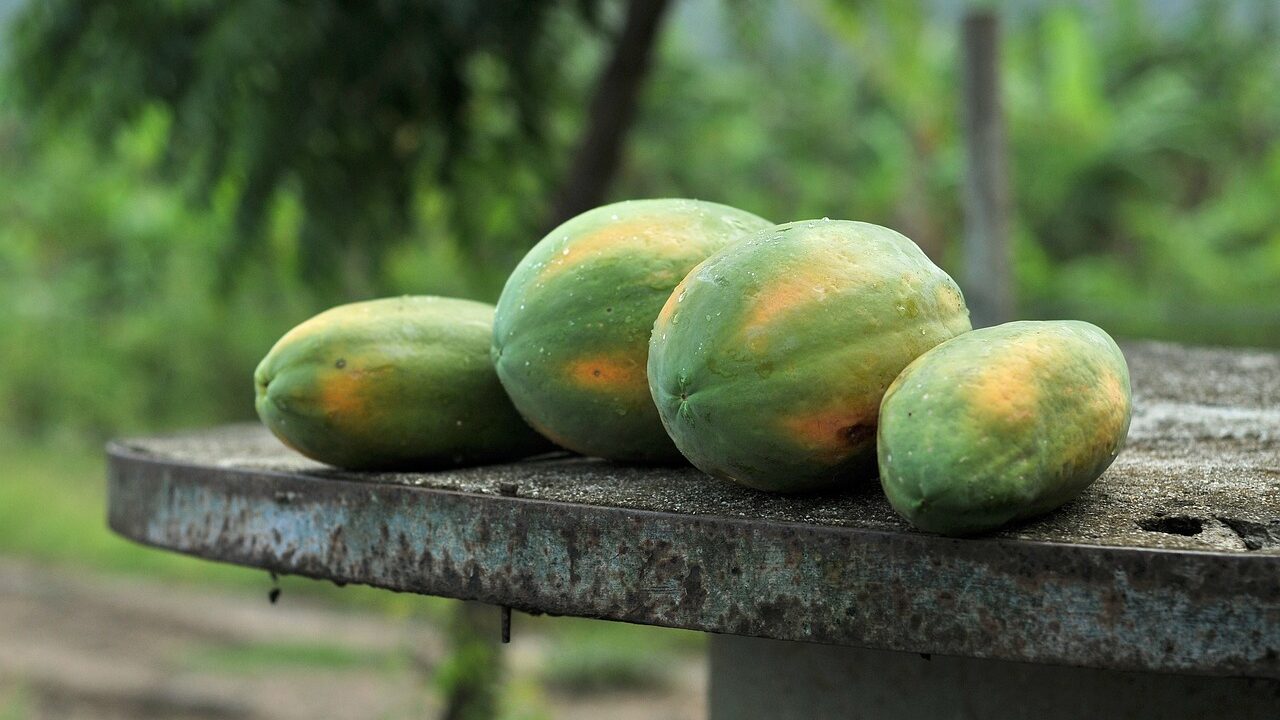
What is the taste of papaya like? Papaya is an oval fruit, resembling a pear in shape. Its greenish-yellow skin encloses orange or salmon-colored flesh. Inside the fruit, you'll find black, round seeds that can also be eaten, although they may not be particularly delicious. The seeds have a somewhat peppery flavor with a noticeable touch of bitterness. Underneath the skin lies a creamy interior, described as a delightful blend of mango and melon flavors. It offers sweetness while providing refreshing qualities.
From a horticultural perspective, the papaya plant is known for its perennial nature and its ability to bear large and delicious fruits. Interestingly, papaya is not only suited for thriving in the wild but can also be grown successfully in apartments. In this informative piece, you will discover the various nutritional and health benefits associated with papaya fruit. Additionally, you will gain insights into how to successfully cultivate papaya in a pot, garden, or even a greenhouse.
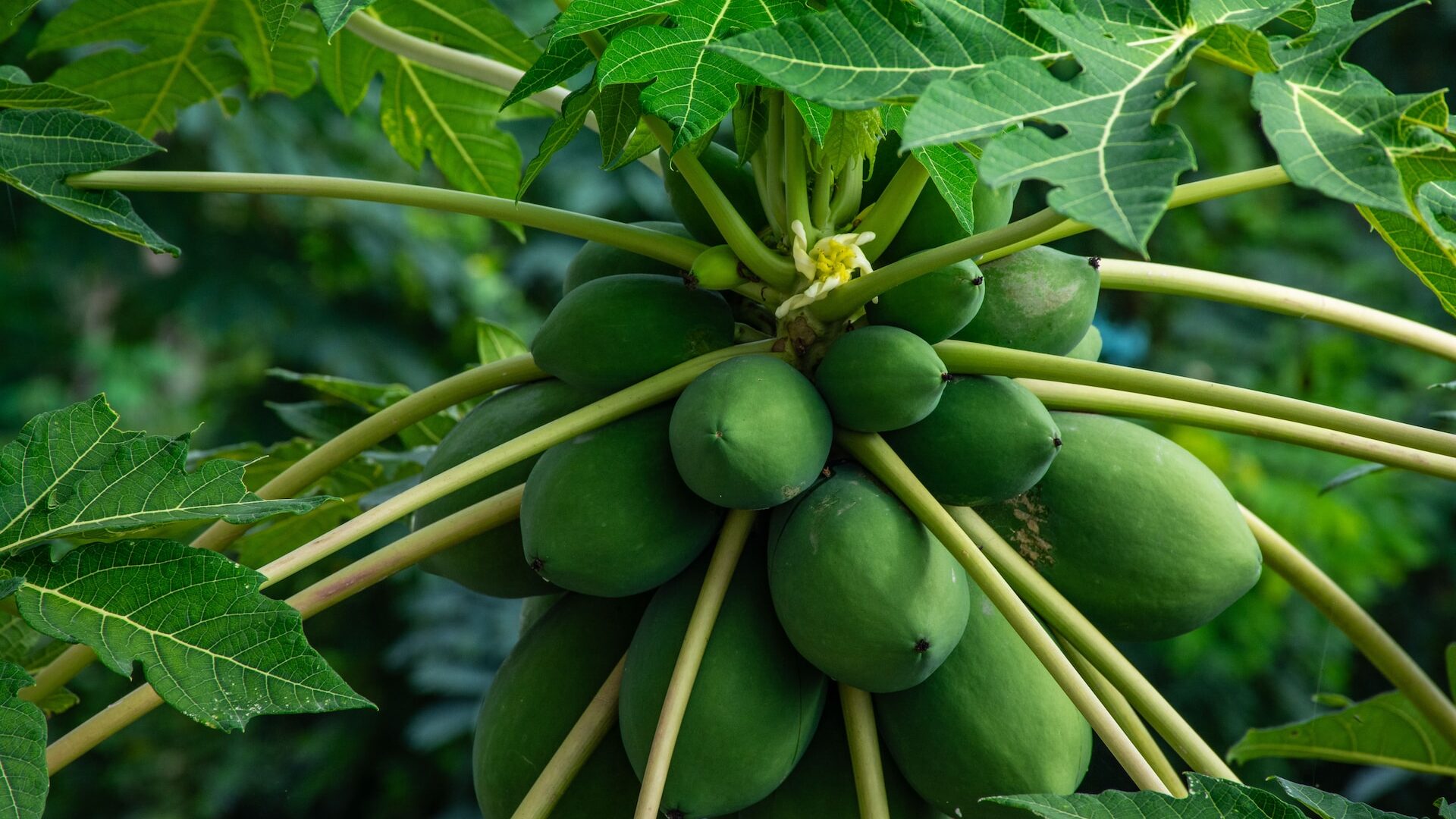
Location – Greenhouses and conservatories offer ideal growing conditions for papaya plants. In these environments, papaya plants thrive and grow vigorously. However, it is important to protect them from direct sunlight, especially during hot weather. When growing papaya at home, it is recommended to choose a well-lit room near a window. If natural light is insufficient, supplement it with plant lamps. Alternatively, papaya can be cultivated in a pot, but make sure to select an appropriate-sized container for easy management.
Temperature – Papayas thrive in warm conditions. During the summer, it is best to keep the plant in a room with an air temp of 24°C/75°F. In the winter, the temperature should range between 18-24°C/65-75°F, ensuring it never drops below 18°C/65°F. To support the plant in winter, artificial lighting can be used. Additionally, it is important to shield the plant from wind and drafts to ensure its well-being.
Seeds – It is advisable to sow only fresh seeds. Prior to sowing, ensure the seeds are cleaned from any flesh. It is also recommended to soak them in water the day before sowing. Another good option is to soak them in a solution of potassium permanganate.
Soil – The growing site should be filled with fertile soil. It is best to mix peat soil with clay soil, compost soil, and sand. The substrate must be fertile, well-loosened, and permeable with a slightly acidic reaction. Since papaya grows quickly, it is necessary to feed it. Every two weeks or so, provide the melon tree with universal fertilizers. Young plants should be repotted yearly and older plants every two years.
Watering – Papaya plants require regular watering to maintain a consistently moist soil. To prevent root rot, it is important to water sparingly and ensure the pot has proper drainage with holes to allow excess water to escape. Regular sprinkling with soft water is beneficial for papayas. However, during winter, it is advisable to reduce watering and sprinkling. It is crucial to water the plant frequently but avoid excessive amounts. Any accumulated water in the saucer should be promptly emptied to prevent the occurrence of diseases and root rot.
Timing – Papaya takes approximately 6-9 months to mature after planting. Harvesting is ideal when the papaya's skin transitions from green to yellow or orange, and the flesh becomes tender. However, it's important to note that under home conditions, the number and size of fruits are typically smaller compared to those grown in natural environments. It is essential not to rush the harvest, so the fruit fully ripens and its milky juice becomes watery and loses its harmful properties.
Problems – The primary and most common pest of papaya, the spider mite, appears on the plant under room conditions when the humidity level in the room is at its lowest, or the air is dry. Urgent measures include regular spraying. If such measures are unsuccessful, natural complex preparations to control harmful insects will help. Root rot is considered one of the most common diseases. The appearance of this fungal disease is associated with violations of the rules of papaya care in cold seasons.

Papaya, a renowned fruit cherished for its delightful taste and numerous health benefits, is abundantly packed with essential vitamins, minerals, and natural antioxidants. These valuable nutritional components actively contribute to papaya's exceptional healing abilities. However, one may wonder about the specific dietary values that papaya possesses. Papaya consists of 80-90% water and contains a relatively high amount of carbohydrates and small amounts of protein and fats. In addition, it includes the following nutrients:
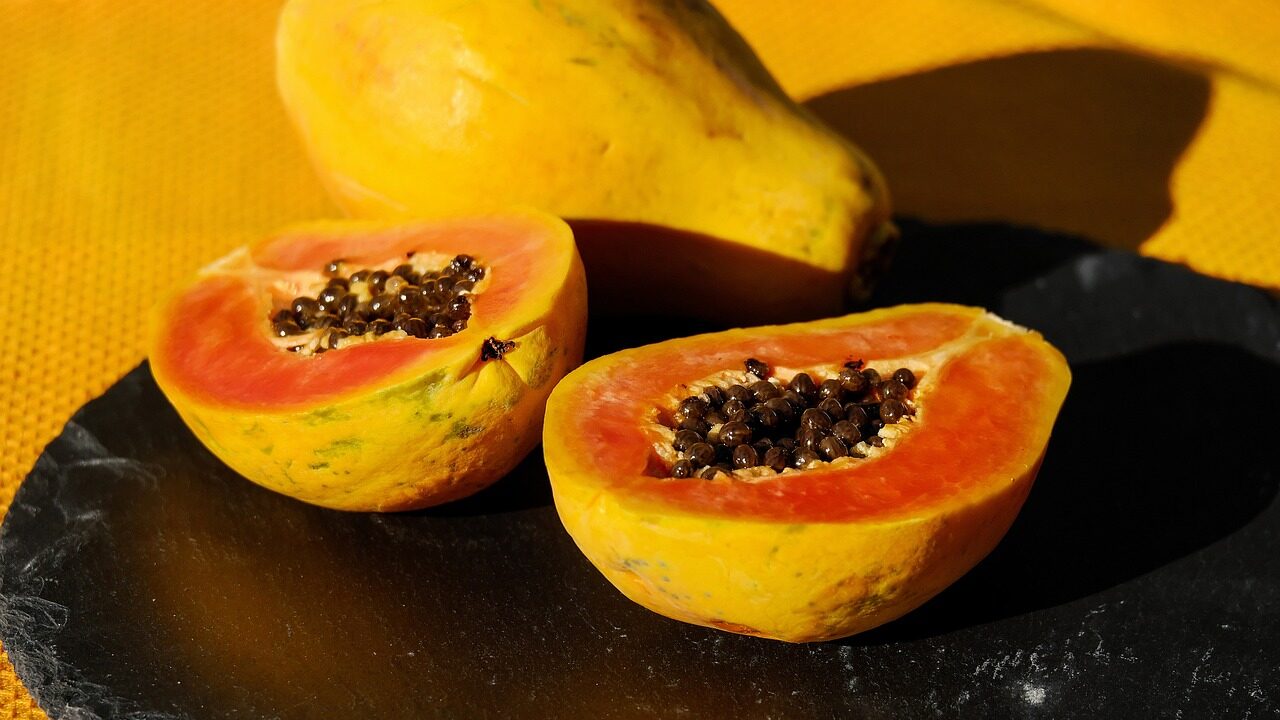
Vitamin A – Papaya has beta carotene or vitamin A. This element has a beneficial effect on visual processes, especially vision after dark, supports the functioning of the immune system, protects against gastrointestinal and respiratory tract infections, lowers serum cholesterol levels, thus reducing the risk of atherosclerosis, and delays skin aging.
Vitamin B – Papaya also has various types of B vitamins. The fruit provides various benefits to our health. It contains vitamin B3, which aids in reducing inflammation of the mouth and skin, and vitamin B9, also known as folic acid. Folic acid is essential for the proper functioning of the nervous, blood-forming, and cardiovascular systems, among other things.
Vitamin C – Papaya is a perfect source of vitamin C. One piece of papaya fruit provides vitamin C in an amount that thoroughly covers the daily requirement. Thanks to this, papaya, among other things, reduces the risk of many cancers, lowers cholesterol and blood pressure, and increases iron absorption.
Vitamin E – Papaya is a good source of Vitamin E, which is a group of compounds called tocopherols. This essential nutrient is soluble in fat and acts as a potent antioxidant. Its primary function is to protect the body from oxidative stress and prevent cell damage caused by free radicals.
Vitamin K – Vitamin K can be found in papaya. This important element helps regulate blood clotting, while also possessing antibacterial and antifungal properties. Additionally, it plays a role in the metabolism of the skeletal system.
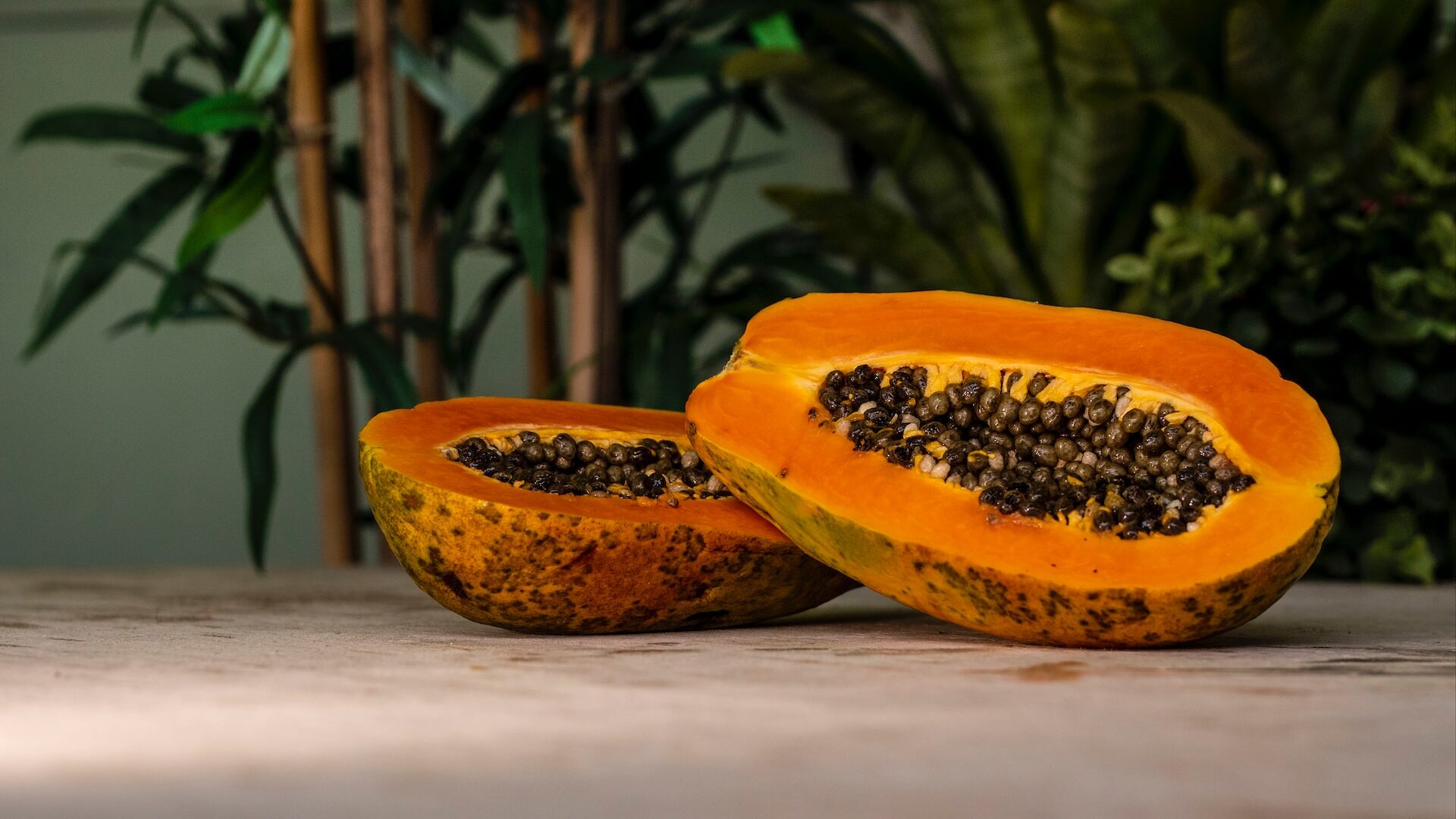
Potassium – One serving of papaya can fulfill over 14% of your potassium needs. This vital mineral is essential for our bodies and acts as a key electrolyte. Consuming enough potassium can lower the risk of various diseases, including cardiovascular conditions.
Magnesium – Papaya is also rich in magnesium, a vital element that plays a crucial role in the human body. One of its key functions is to ensure the proper development of bone tissue, working alongside vitamin D and phosphorus in the process of bone mineralization. This helps prevent conditions like osteoporosis and promotes overall bone health.
Calcium – Calcium plays a vital role in papaya as it contributes to bone formation. Moreover, it aids in the normal functioning of the heart, muscles, and joints, regulates blood clotting, and helps prevent the development of degeneration and cancerous lesions.
Iron – Iron is not abundantly found in papaya. However, papaya contains significant amounts of vitamin C, which aids in the absorption of iron. The body relies on iron for proper growth and tissue regeneration, as well as for bolstering the immune system, supporting heart function and muscle performance, combating free radicals, and alleviating fatigue.
Phosphorus – Phosphorus plays a vital role in the papaya fruit. It is present in every cell of our body and is essential for proper functioning. To carry out its functions effectively, phosphorus requires calcium and vitamin D. Vitamin D aids in the absorption of both calcium and phosphorus, contributing to their overall benefits.
Zinc – Zinc, a mineral found in papaya in small amounts, can be sourced better from other fruits. It plays a crucial role in metabolism, boosts the immune system, reduces inflammation, and aids in the treatment of cold and flu by alleviating their symptoms. Additionally, zinc ensures proper functioning of the reproductive organs and helps prevent prostate diseases.
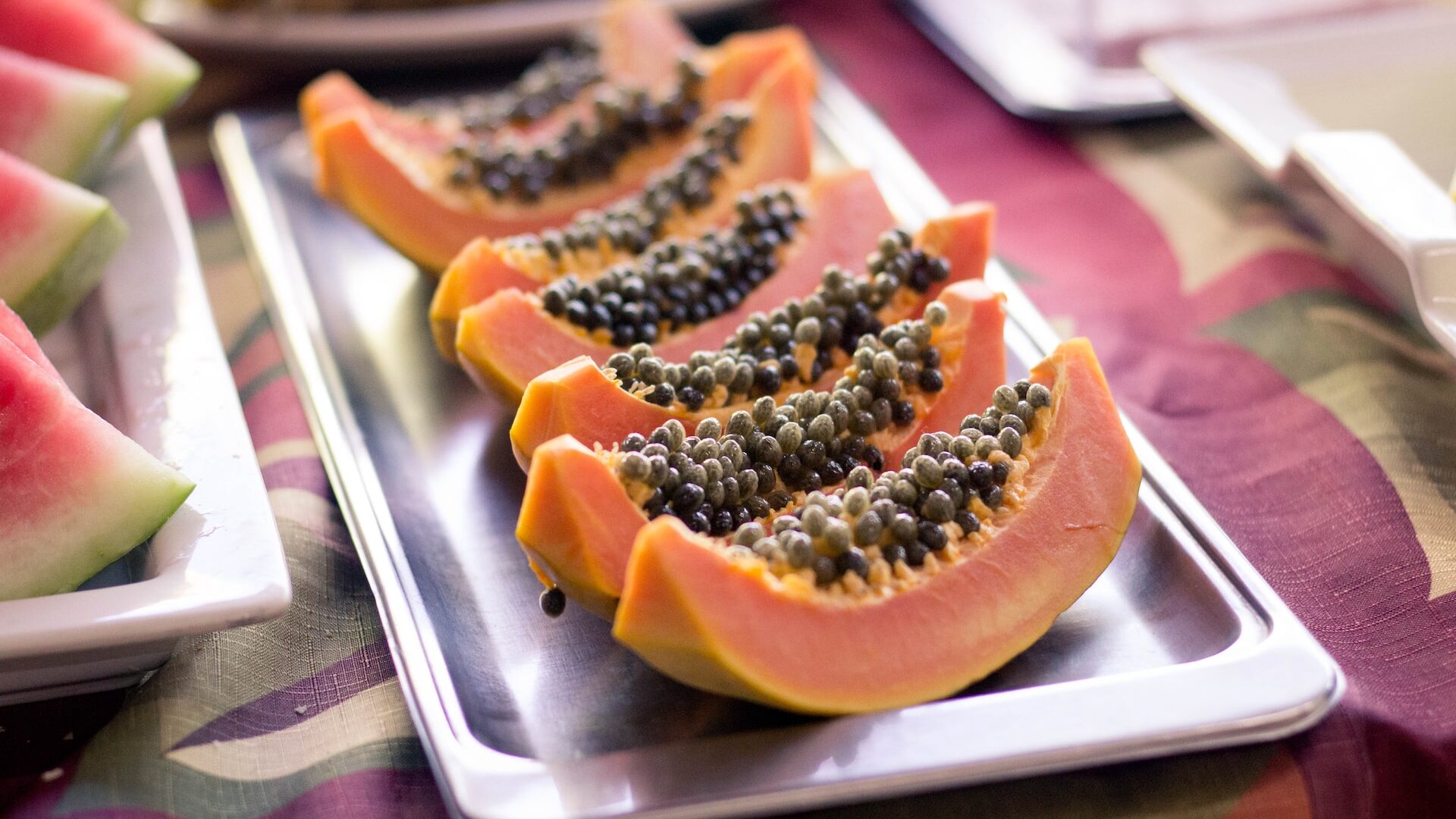
Phenolic acid – Papaya contains a valuable component known as phenolic acid. Phenolic acids possess antioxidant properties, which contribute to protection against various diseases. Additionally, this acid exhibits choleretic effects, safeguarding against bile stasis and the formation of gallstones. Moreover, it demonstrates antimicrobial effects.
Flavonoids – Flavonoids have been found in papaya and they bring about several positive effects. One of their significant contributions stems from their antioxidant activity, which shields against the development of oxidative stress, a root cause of numerous diseases. Moreover, these flavonoids exhibit anti-inflammatory properties. Additionally, they support the protective functions of the skin, safeguarding it against the damaging effects of UV radiation.
Lignans – Lignans, which are found in papaya, are phytoestrogens that have estrogen-like effects. This means they function similarly to female sex hormones and can be particularly beneficial in easing menopausal symptoms. Furthermore, consuming lignans can help lower the risk of breast cancer in postmenopausal women.
Lutein – Lutein, a beneficial nutrient found in papaya, has several impactful effects on vision health. It acts as a protective shield for the retina against harmful UV radiation, preventing potential damage. Not only that, lutein also possesses anti-inflammatory and antioxidant properties, promoting overall eye health. Furthermore, this powerful compound in papaya offers additional benefits, such as protection against dementia and cardiovascular disease.
Lycopene – Papaya is an excellent source of lycopene, which is known for its powerful antioxidant properties. By protecting the body against harmful free radicals, papaya helps prevent oxidative stress, which is associated with numerous diseases. According to scientists, lycopene supplied to the body in adequate amounts can minimize the risk of cancer of the prostate, cervix, breast, pancreas, or lungs.
Fiber – Papaya, like other fruits, also contains fiber. You will find little thread in papaya, but in a varied diet, it should be enough. Among other things, fiber maintains the feeling of satiety after a meal. It prevents constipation, hemorrhoids, and colon cancer. Fiber also stabilizes sugar levels, so papaya in small amounts is allowed for people with diabetes.
The calorific value of papaya is worth exploring. Papaya not only enhances the taste of dishes but also adds nutritional value to them. However, if you aim to lose weight, should papaya be a part of your diet? Well, papaya consists mainly of water (80-90%), with moderate amounts of carbohydrates and small quantities of protein and fats. Comparing its calorie content with other fruits, papaya falls into the low-calorie category. In moderation, you can enjoy papaya while on a weight-loss diet. Still, if weight management is your goal, there are even lighter choices available among fruits.
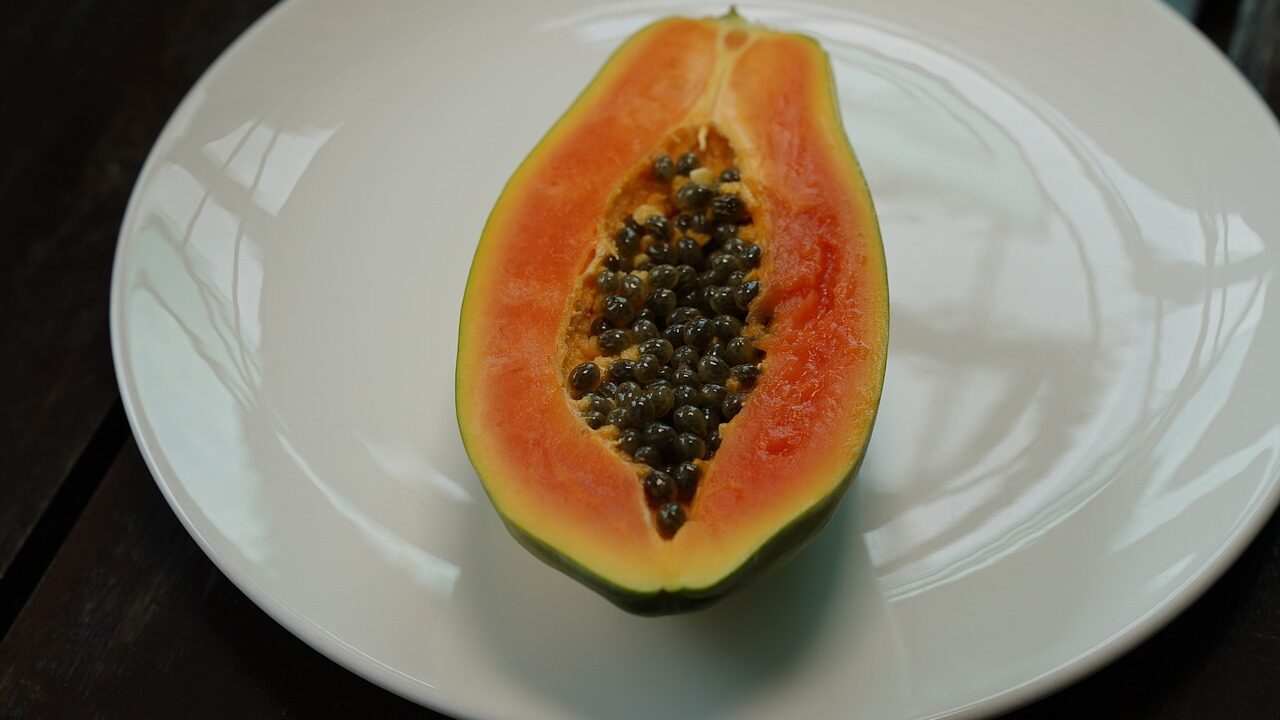
Nutritional values are for ripe papaya. Unripe fruits always contain less sugar than their mature versions. However, the unripe fruit is complex and has green skin. It is edible but slightly bitter and can spoil the taste of some dishes. People with diabetes can also eat papaya. Although this fruit is lovely, you can continue eating papaya if you stick to the designated portions.
Papaya, a delicious and naturally sweet fruit, offers numerous health benefits beyond its delightful taste. Maintaining a balanced diet entails incorporating vegetables and fruits as vital components. If you want to diversify your eating habits, consider adding the exceptional papaya. Regular consumption of papaya can positively impact your well-being in various ways:
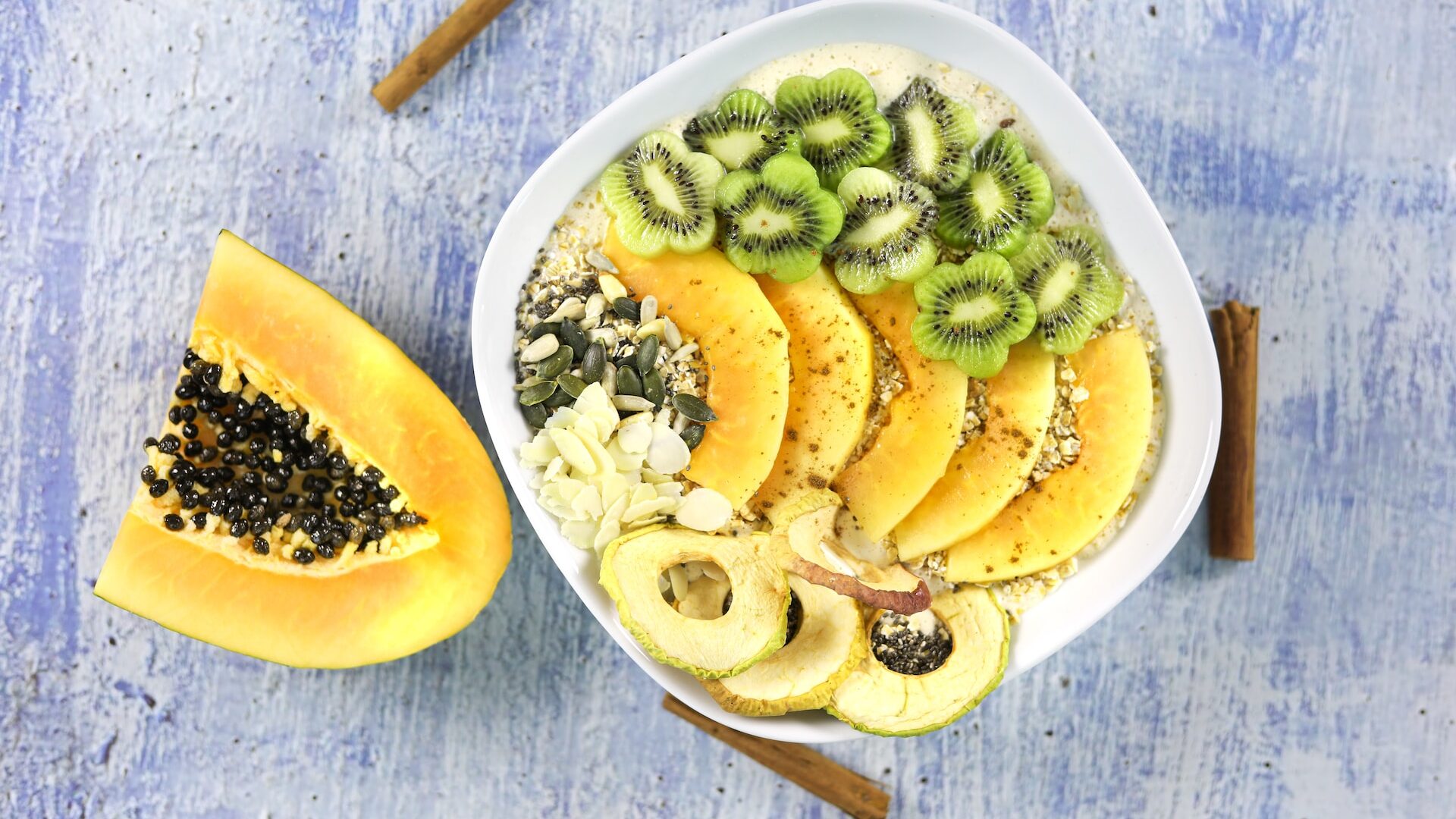
Immune system support – Papaya is a fantastic supporter of the immune system. Papaya is packed with vitamin C, which not only boosts immunity but also enhances overall body function. Moreover, this tropical fruit showcases remarkable antibacterial and antiviral effects, which can help alleviate symptoms of colds and seasonal infections. Additionally, papaya aids in restoring damaged intestinal walls commonly associated with irritable bowel syndrome.
Digestive system support – Papaya is well-known for its ability to support the digestive system by aiding in digestion, detoxifying the body, and promoting regeneration. The fiber in papaya helps absorb water, which enhances digestion efficiency. Moreover, it regulates the secretion of digestive juices and provides long-lasting satiety after meals.
Liver support – Papaya seeds help cleanse the liver by eliminating toxins. A month-long treatment involving a specific dosage of papaya seeds can effectively enhance liver health, significantly if it has been damaged due to excessive alcohol consumption, diseases, or poor dietary habits. Despite their bitter taste, incorporating papaya seeds into your diet is highly recommended owing to their exceptional properties.
Blood clotting improvement – Papaya is known to enhance blood clotting, making it helpful for promoting wound healing. Its fibrous components create a network at the site of injury, which speeds up the clotting process. Moreover, when papaya is applied topically, it not only aids in wound healing but also provides protection against potential infections.
Eye protection – Eye protection is of utmost importance. It is crucial to safeguard our eyes from potential harm. Moreover, papaya is a rich source of zeaxanthin, a powerful compound that acts as a natural filter against the sun's harmful radiation. To maintain optimal eye health, it is essential to include foods with vitamins (A, B, C, and E) all of which can be found in papaya.
Beneficial effects on fertility – The presence of arginine in papaya has beneficial effects on fertility. It helps treat infertility by increasing sperm production in men. In women, arginine aids in improving mucus production, enhancing uterine blood supply, and promoting egg maturation.
Weight loss support– Papain, found in the fruit, supports weight loss by aiding digestive processes, accelerating the burning of proteins and fat, promoting body detoxification, and facilitating the reduction of excess weight. Additionally, it helps prevent bloating and constipation.

When it comes to enjoying a delicious papaya, proper preparation is key. Whether you want to savor the fruit as is or incorporate it into a mouthwatering dessert or dish, follow these simple steps:
And there you have it – the papaya can be easily cut into pieces of your desired size. The fruit tastes deliciously sweet even without any additives. For a slight twist in flavor, consider sprinkling a little lemon juice over it to balance the sweetness subtly.
When you cut papaya and extract the dark seeds, you can eat them because they are safe and have valuable health properties. The seeds of papaya are rich in digestive enzymes, which support healthy digestion and the overall digestive system. Additionally, these seeds exhibit anti-inflammatory and antibacterial properties. In some cases, they are even used as an anti-parasitic medication, aid in kidney function, or as a natural liver cleanser.
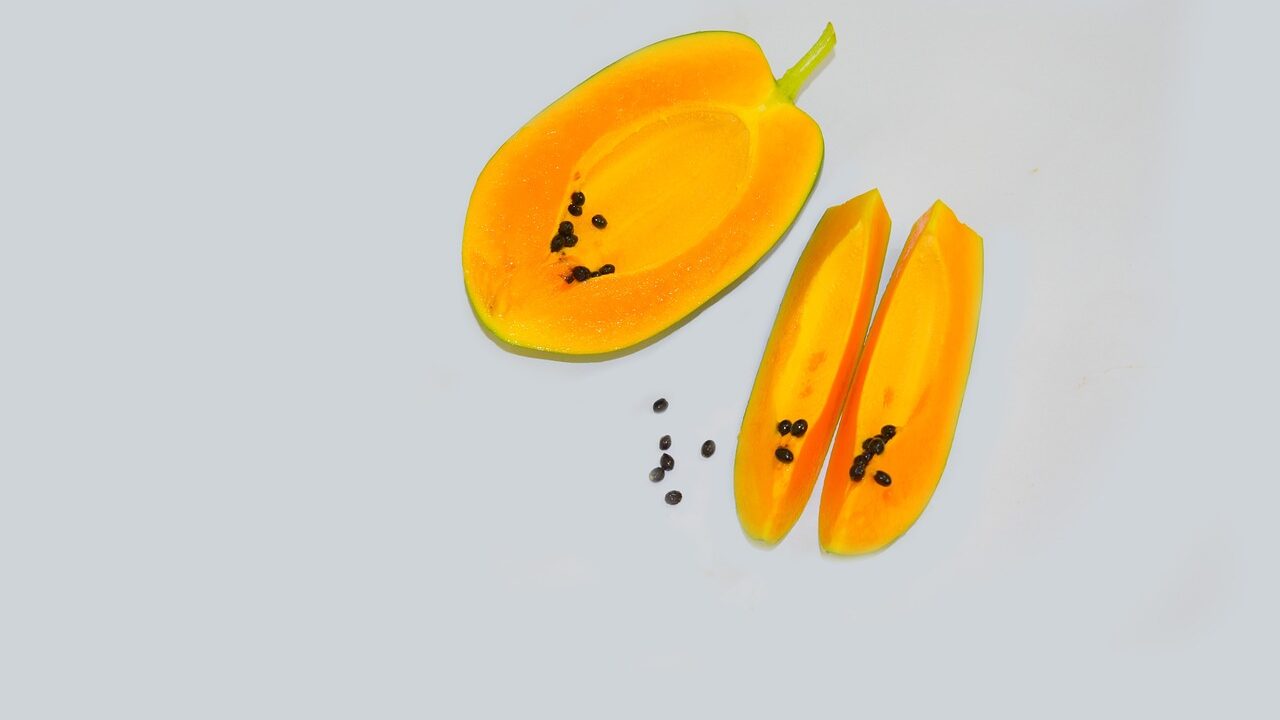
Should the beneficial health properties of papaya seeds pique your interest, you may choose to try them and explore their distinctive bitter taste. Because of this bitter and spicy taste, it is worth drying the seeds, pulverizing them, and using them as a seasoning for dry dishes. If you're wondering how to eat papaya along with the seeds, it's worth remembering that you can also throw them into a blender, seasoning fruit and vegetable smoothies. Consumption of papaya seeds is discouraged only for pregnant women.
Ripe papaya fruits have versatile uses in various recipes. They can be blended into delicious smoothies or incorporated into delightful desserts. Additionally, they make for a great salad ingredient and can serve as a flavorful topping for oatmeal. If you are feeling adventurous, add papaya seeds to a salsa-type sauce to give it a unique peppery twist. To help you thoroughly enjoy the taste qualities of papaya, we are delighted to share some delectable recipes you can try out.
Thais consider this salad their national dish because it perfectly embodies the essence of Thai cuisine: a delightful medley of flavors. It skillfully combines four distinct tastes – sweet, salty, sour, and spicy. So why not indulge in its simplicity? Enjoy!

Cut the papaya, melon, and onion into thin strips. The cherry tomatoes should be cut in half. Next, grind garlic, sugar, nuts, chili, and cilantro together in a mortar until a smooth paste forms. Once a homogeneous paste is obtained, add fish sauce and lime juice. Set the mixture aside in the refrigerator. In a bowl, place the sliced papaya and pour a small amount of the sauce over it. Mix well until the papaya absorbs the sauce. Then, gently add the tomatoes, melon, onion, and arugula to the mixture and combine.
Looking for a refreshing and hydrating option? Consider making a papaya smoothie. This delicious blend of ingredients offers a unique and delightful taste experience. Moreover, a glass of papaya smoothie provides an abundance of nutritious elements. Incorporating this beverage into your daily routine can significantly benefit your overall diet and well-being.

To make a refreshing papaya smoothie, start by cutting the papaya in half and scooping out the seeds using a spoon. Next, use the spoon to remove the pulp and add it to a pitcher. Peel the banana and add it to the mix as well. Finally, enhance the flavor by adding a tablespoon of honey, lemon juice, yogurt, and plant milk. Give it a good blend using a blender until everything is well combined. Serve the smoothie in glasses, garnishing them with a slice of orange for an extra touch of freshness.
Table of Contents
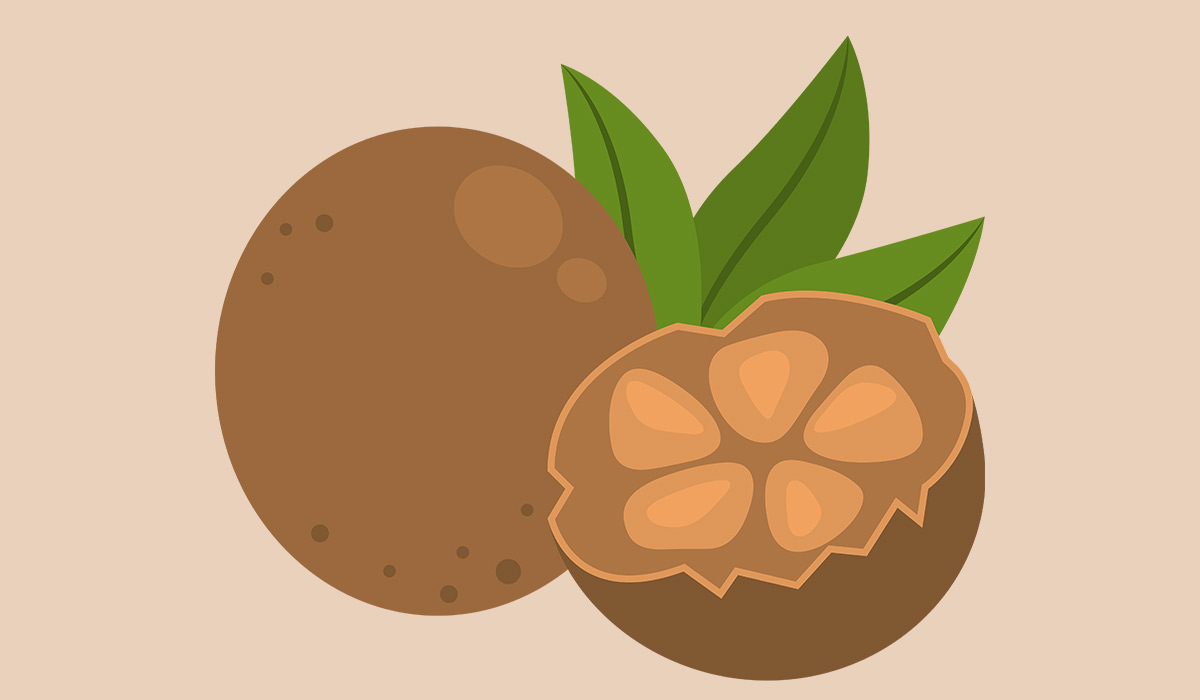
Monk fruit is an extraordinary plant with many health properties. The processed fruit can be used as a substitute for… read more »

Dragon fruit is an exotic fruit that combines the taste of kiwi, pear, and citrus. It's known for its red… read more »

Bananas are a nutritious and healthy food. Eating bananas can bring many benefits. However, the fruit is high in calories.… read more »

Lychee is a fruit known for its exceptional flavor. Discover the health benefits of incorporating lychee into your diet, and… read more »

Pumpkin is a popular plant that has benefited people for years. Find out how pumpkin affects health and its calorie… read more »
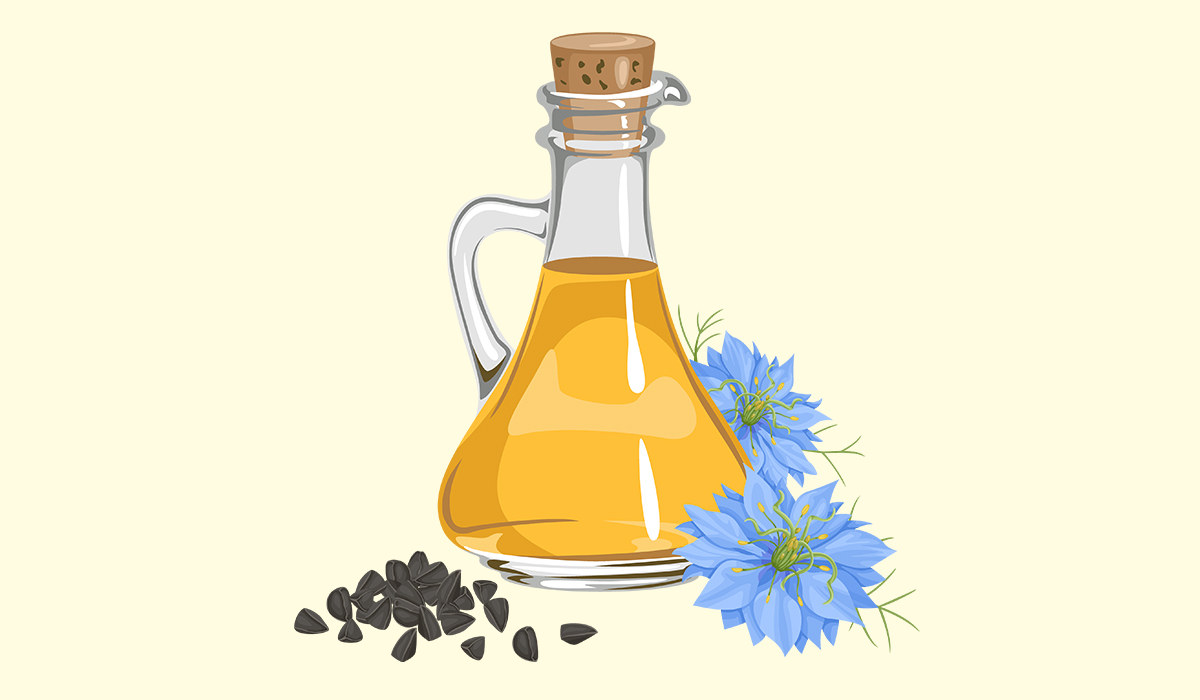
Healthier heart, lungs and kidneys. Black cumin oil is a plant product known for its many health benefits. Find out… read more »
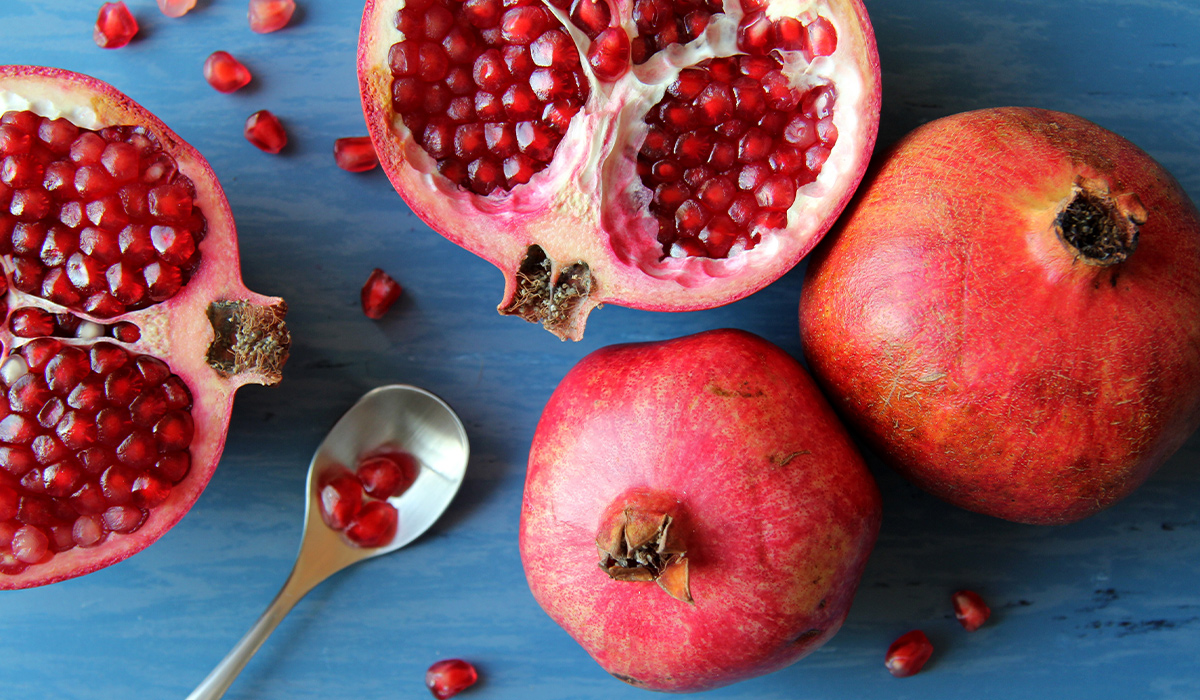
Arils, the edible part of pomegranate, are ruby-colored seeds packed with beneficial nutrients. Adding pomegranate seeds to a diet is… read more »

Cellulite is an abnormal distribution of adipose tissue, leading to changes in the subcutaneous tissue. Why is this happening? How… read more »

Strawberries are a beloved fruit, known not only for their delicious taste but also for their abundance of vitamins. Let's… read more »